Modification of the Differential Transform Method With Search Direction Along the Spatial Axis
Abstract
This paper presents a modification of the Differential Transform Method (ModDTM) formulated so that the search direction of the solution is along a spatial axis (x). It is shown that the method is applicable to a wide spectrum of (1 + 1) partial differential equations, integro partial differential equations, and integral equations. The solutions obtained are in the form of a Taylor series, the coefficients of which are determined by recursively operating a differential transform of the equation. These solutions are either exact and in closed form, or are good approximations. To illustrate the application of the method, as well as to show its versatility, examples are chosen from all the categories mentioned earlier. These include equations such as the nonlinear Fisher, combined KdV-mKdV, Hunter–Saxton (H-S), Fornberg–Whitham (FW), coupled systems such as the Whitham–Broer–Kaup (WBK) and the sine-Gordon (s-G) equations, integral equations, Volterra partial integro-differential equations (PIDE), and linear and nonlinear versions of the (complex) Schröedinger equation. The Tables and 3D-plots show the good rate of convergence of the obtained solutions with the exact ones. It is thus found that the new scheme is successful in producing satisfactory results as any other method in which the conventional approach of searching for solutions along the temporal axis is followed. Further, the procedures involved are simple, and hence may be operated with great ease.
1. Introduction
Finding analytical solutions of partial differential equations (PDE) is of vital importance because of their wide range of applications in engineering, medicine and other sciences. Various methods have been devised for this purpose such as the classical methods, which are particularly applicable to linear PDEs, and semianalytical methods such as the Adomian Decomposition Method (ADM), the Homotopy Perturbation Method (HPM), and the Differential Transformation Method (DTM), among several others, and their improvements and adaptations. The main advantage of semianalytical methods such as those mentioned here is that they are applicable to a wider category of differential equations (DE), including nonlinear PDEs (NLPDE), integro-differential equations, fractional PDEs, and fuzzy PDEs. In [1], Lu and Zheng applied the ADM, as well as ADM with integrating factor (ADMIF), to symbolically solve PDEs without specifically prescribed initial data. The Elzaki transform was combined with the projected DTM to solve the Schrödinger equation in [2]. Sivasundaram, Kumar, and Singh [3] applied the sine-Gordon Expansion Method (SGEM) and its rational form (RSGEM), which are procedures derived from the solution of the sine-Gordon (s-G) equation, to determine waveform solutions of the first of the Kadomtsev–Petviashvili hierarchy. In another modification, the DTM was coupled with the techniques of Laplace transformation and Padé approximation for solving Volterra IDE and pantograph type DEs with proportional delays [4]. In recent years, there have been devised a multitude of adaptations of the standard methods to cater to fractional PDE (FPDEs). These equations are significant since several phenomena in the fields of electrodynamics, random walk, biotechnology, signal and image processing, and nanotechnology, to name just a few, are modeled using FPDEs. Alaje et al. [5] applied a modified form of the HPM for solving a fractional version of the Korteweg de-Vries equation with Caputo fractional derivatives. The modification involves the application of a power series of arbitrary order as the initial correctional function. A revised form of the Extended Direct Algebraic Method, called the r + mEDAM, was used by Yasmin et al. [6] to extract stochastic soliton solutions of the fractional stochastic Kraenkel–Manna–Merle system. The solitons generated were in the form of trigonometric, hyperbolic, and rational functions. The Iterative Transform Method (ITM), another reliable tool suitable for PDEs, has been effectively applied for solving the fuzzy fractional Degasperis–Procesi and Camassa–Holm equations in [7]. This type of FPDEs are used as models of systems with uncertain or imprecise information, and as such have fuzzy initial conditions. By the application of the ITM, the equations were first converted into a series of ordinary differential equations (ODE), which were then solved iteratively using a recursive algorithm.
Of the different semianalytical methods in existence, the DTM is a powerful and versatile method that is applicable to a variety of equations such as ODEs, PDEs, fractional PDEs, delay DE, and fuzzy PDEs [8–11]. It was first applied in 1986 by Zhou to find solutions of electric circuit problems [11]. The method is built upon a differential transform (DT) that defines the (k, h) transform of a function, say u(x, t), as follows:
Definition 1. Let u(x, t) be a function that is continuously differentiable with respect to x. Then, the differential transform of u(x, t), denoted by U(k, h), is defined as
It is to be noted that U(k, h) is the coefficient of xkth in the Taylor series of the function developed about the origin. When applied to a DE, it gets converted to an algebraic recurrence relation, which in turn generates the Taylor series coefficients of the solution u(x, t). The inverse DT given by Definition 2 is then applied to determine u(x, t). As is known, the Taylor series is convergent only in narrow neighborhoods of (0, 0), which is about which the DT above is defined. Thus, in order to obtain a good approximation of the exact solution to a given problem, a large number of terms is required in the series representation. This makes the computations involved in the DTM, voluminous. Additionally, the complexity of the transform is expected to increase with the complexity of the equation. These are aspects of the DTM that will be addressed by the new modification.
Definition 2.
More often than not, the existing classical and semianalytical methods, including the DTM, use procedures that are directed along the time-axis. The rationale behind such a practice might be the fact that the problems modeled by the equations solved are deemed to be evolving with time. Moreover, they are mostly of order two in the time variable t, and hence require fewer initial conditions. Nevertheless, the other independent variable in the equation, which is most often a spatial variable, has the same theoretical significance as the temporal one. Hence, it is equally possible to consider the PDE to be evolving with respect to this variable, and so may be solved as a space-dependent equation. This idea was examined in [12] by the formulation of a new modification of the DTM, called the ModDTM, which is short for modified DTM. In this modification, the differential transform (1) is refined in such a way that a function u(x, t) gets represented as an infinite series containing powers of x with functions of t as coefficients, as opposed to the procedure of the DTM which generates series solutions involving powers of both x and t. Thus, in the application of the ModDTM a PDE will be transformed to an ODE in t, creating a recurrence relation that will be applied recursively to find the unknown coefficients in the series solution, thereby simplifying the procedures comparatively. It is also expected that the new procedure will require a lesser volume of computations to generate solutions with convergence properties similar to that of the DTM generated solution, even when applied to NLPDEs of high complexity, as well as to other types of DEs.
Boundary value problems (BVP) form a significant class of DEs due to their applications in fluid mechanics and other engineering problems, as well as in the modeling of tumor and its treatment. Even though the DTM is applicable to BVPs of ODEs [13, 14], the method is not well suited to be applied to such problems of PDEs. Since the ModDTM focuses on finding solutions in the x-direction, the prescribed initial data correspond to x. This feature of the method may facilitate using the ModDTM with a suitable adaptation for solving BVPs of PDEs, thereby creating a way forward to deal with such problems.
In this paper, the ModDTM is re-introduced as a method for solving not only NLPDEs, but also other types of equations, such as coupled systems of nonlinear PDEs, integral equations, partial integro-differential equations, and equations involving the complex variable i. The remaining part of the paper contains the following sections. Section 2 discusses the methodology of the ModDTM in detail. In this section the properties of the method and the symbolic derivation of the recurrence relation that determines the coefficients occurring in the power series solution are included. Convergence of the solutions is also proved theoretically. Illustrative examples are found in Section 3. They include NLPDEs such as the Fishers, the combined KdV-mKdV, the Hunter–Saxton (H-S) and the Fornberg–Whitham equations. These equations are of high complexity since they contain several nonlinear terms. The last two involve cross-derivatives as well, the presence of which is usually dealt with a suitable variable change in order to remove the cross derivatives. This is to avoid spurious solutions and other instabilities that arise due to their presence [15]. Coupled (1 + 1) systems like the Whitham–Broer–Kaup (WBK) equations and the sine-Gordon equations (s-G) are also included. Such systems are used to model problems of physical and engineering sciences such as fluid flow, reaction-diffusion systems, spread of epidemics and population growth/decay, which cannot be represented completely by single PDEs as they involve the simultaneous occurrence of several processes. Integral equations (IE) form the next category of equations solved. These equations contain the integral of the function that is to be determined, instead of its derivatives. An IE is equivalent to a corresponding differential equation combined with suitable initial or boundary conditions. Large-scale control-volume analyses, such as those required in fluid flow problems, are possible with solutions of integral equations rather than with those obtained by solving the corresponding differential equations. This is so because the domain of application of the former is much larger than that of the latter [16]. IE are followed by partial integro-differential equations (PIDE). This type of equations finds applications in areas of probability theory, fluid mechanics, and epidemiology [17, 18]. They contain both the derivatives as well as the integral of the unknown function. The section ends with the Schröedinger equation, the most important equation in quantum wave theory [19] as it describes different types of microscopic phenomena in the best possible manner. The Schröedinger equation serves as a model for problems in optics, plasma physics, superconductivity, in addition to those in quantum mechanics [20]. In Section 4, the ModDTM is compared with the DTM and the Elzaki Homotopy Transformation Perturbation method obtained by coupling the HPM with Elzaki Transformation. Discussion of results is included in Section 5. Finally, conclusions about the work are drawn in Section 6.
2. Methodology of the Modified Differential Transform Method
The modified differential transform method (ModDTM) [12] is a variation of the DTM. The difference is mainly to do with the way in which a function is transformed in the two methods. While in the DTM, the transform of a function u(x, t) is a constant as seen in (1), its (modified) differential transform (ModDT) is a function of t, as defined below [12].
Definition 3. Let u(x, t) be a function that is continuously differentiable with respect to x. Then, the differential transform (ModDT) of u(x, t), denoted by Uk(t), is defined as
Thus, the k th transform of u(x, t) is determined by differentiating the function partially with respect to x, k times, and then evaluating the resulting function at x = 0. Since the ModDT of u(x, t) is a function of t, the inverse ModDT is defined in such a way that the function will be represented as an infinite series in x, in which the coefficients of the terms are functions of t, as represented below [12].
Definition 4. Suppose Uk(t) is the kth transform of the function u(x, t). Then its inverse transform is defined as
2.1. Properties of the Modified Differential Transform
The properties stated below may be deduced from definition (3) of ModDT [12].
Theorem 1. If w(x, t) = u(x, t) ± v(x, t), Wk(t) = Uk(t) ± Vk(t).
Theorem 2. If w(x, t) = αu(x, t), α ∈ R, Wk(t) = αUk(t).
Theorem 3. If w(x, t) = ux, Wk(t) = (k + 1)Uk+1(t).
Theorem 4. If w(x, t) = ut, Wk(t) = ∂/∂t[Uk(t)].
Theorem 5. If w(x, t) = (∂ru/∂xr), Wk(t) = (k + 1)(k + 2) … (k + r)Uk+r(t).
Theorem 6. If w(x, t) = (∂hu/∂th), Wk(t) = ∂h/∂th[Uk(t)].
Theorem 7. If w(x, t) = u(x, t)v(x, t),
Theorem 8. If w(x, t) = uux,
Theorem 9. If w(x, t) = uxuxx,
Theorem 10. If w(x, t) = uuxxx,
Theorem 11. If w(x, t) = u3,
Theorem 12. If w(x, t) = xmf(t), then
Theorem 13. If w(x, t) = c, where c is a constant, then
Theorem 14. If w(x, t) = ex, then
Theorem 15. If w(x, t) = ex+t, then
Theorem 16. If , then,
Theorem 17. If Uk(t), Vk(t), Hk(t), and Wk(t) denote the transforms of u(x, t), v(x, t), h(x, t), and w(x, t), respectively, then
- (a)
given that
() - (b)
given that
()
2.2. Derivation of the Recurrence Relation
When presented with a PDE, the first procedure of the ModDTM is to determine the transform of the equation by applying the definitions and properties stated above. The transformed equation can generally be operated algebraically, even though it will turn out to be a first order differential equation in t. By its recursive operation, the coefficients of the power series representation of the solution function are determined, the first few of which are obtained from the initial conditions. The final step is to determine the solution by using the inverse transform. In this section, the symbolic form of the said recurrence relation is derived theoretically.
If the order of L(u) is different from two, the equation above will be modified correspondingly.
2.3. Convergence of the ModDTM
The Banach fixed point theorem [21, 22] is applied to prove the convergence of the ModDTM.
Theorem 18. Let C(Ω, ‖⋅‖∞) be the Banach space of continuous functions on . The series converges to S ∈ C(Ω, ‖⋅‖∞) if there exists an α given by 0 ≤ α < 1 such that ∀k ≥ 0
Proof 1. If the sequence of partial sums of the given series is , then Sn is given by
The metric induced by the norm is
Since each Sn belongs to C, we show that the sequence is Cauchy so as to ensure its convergence, as C is a complete space. Define a mapping T : C⟶C such that Sn = T(Sn−1), with S0 = U0(t). It is easy to verify that T is a contraction mapping. Also,
For positive integers m, n such that m > n, the following is obtained with the application of the triangle inequality.
Since (1 − αm−n) < 1. As ‖U0(t)‖ is fixed, the right-hand side of the above inequality can be made as small as required by choosing sufficiently large values of n, as 0 ≤ α < 1. Hence, given ϵ > 0, there exists a large positive integer N such that, ∀m, n > N,
This shows that {Sn} is a Cauchy sequence. Hence, the sequence converges to some S in C. All that is needed now is to prove that S is a fixed point of T, that is, T(S) = S. Applying the triangle inequality once again,
Since {Sn} is convergent, for a given ϵ > 0, and for suitably large values of m, each quantity on the right hand side of the inequality can be made smaller than ϵ/2, implying that d(S, T(S)) = 0, proving that T(S) = S. Finally, it is to be shown that S is unique. Assume, to the contrary, that there exists a such that . Then, , which is possible if, and only if, , as α < 1. Thus, S is uniquely determined as the fixed point of the mapping, completing the proof of the theorem.
Note: Alternatively, it is established that convergence occurs in Ω = [a, b] × [c, d] if, for each k ≥ 0, αk, as defined below, is less than one.
Definition 5.
3. Numerical Examples
3.1. The Fishers Equation
| x | t = 0.0 | t = 0.25 | t = 0.5 | t = 0.75 | t = 1.0 |
|---|---|---|---|---|---|
| 0.0 | 0.00 | 0.00 | 0.00 | 0.00 | 0.00 |
| 0.1 | 1.934e − 8 | 3.613e − 9 | 1.037e − 8 | 3.897e − 10 | 7.915e − 10 |
| 0.2 | 5.700e − 7 | 1.493e − 7 | 3.396e − 7 | 1.113e − 8 | 2.557e − 8 |
| 0.3 | 3.953e − 6 | 1.396e − 6 | 2.639e − 6 | 7.353e − 8 | 1.960e − 7 |
| 0.4 | 1.507e − 5 | 7.016e − 6 | 1.137e − 5 | 2.600e − 7 | 8.337e − 7 |
| 0.5 | 4.117e − 5 | 2.491e − 5 | 3.544e − 5 | 6.298e − 7 | 2.567e − 6 |
The plots in Figure 1 show both the exact and the ModDTM solutions of the Fishers equation.
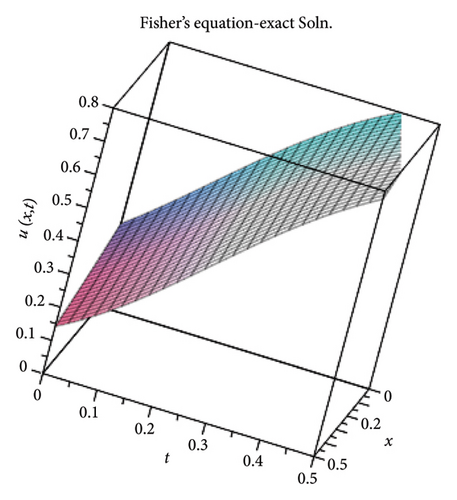
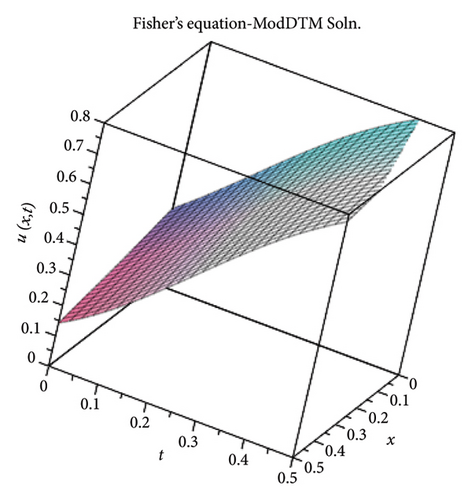
3.2. The Combined KdV-mKdV Equation
| x | t = 0.0 | t = 0.1 | t = 0.2 | t = 0.3 | t = 0.4 | t = 0.5 |
|---|---|---|---|---|---|---|
| 0.0 | 0.00 | 0.00 | 0.00 | 0.00 | 0.00 | 0.00 |
| 0.1 | 8.438e − 8 | 7.941e − 8 | 6.270e − 8 | 2.854e − 8 | 2.684e − 8 | 1.048e − 7 |
| 0.2 | 5.336e − 6 | 4.977e − 6 | 4.114e − 6 | 2.593e − 6 | 3.279e − 7 | 2.687e − 6 |
| 0.3 | 5.959e − 5 | 5.481e − 5 | 4.536e − 5 | 3.029e − 5 | 9.259e − 6 | 1.752e − 5 |
| 0.4 | 3.259e − 4 | 2.952e − 4 | 2.419e − 4 | 1.631e − 4 | 5.839e − 5 | 7.012e − 5 |
| 0.5 | 1.202e − 3 | 1.072e − 3 | 8.661e − 4 | 5.784e − 4 | 2.113e − 4 | 2.257e − 4 |
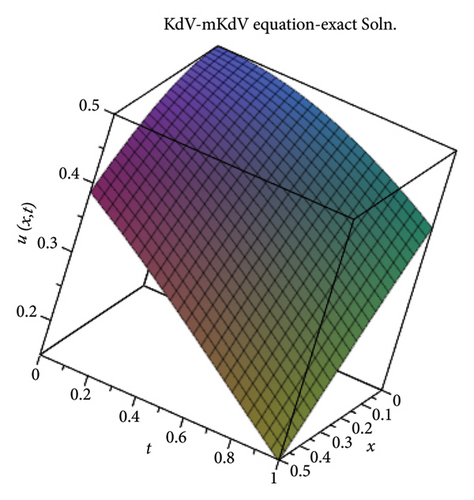
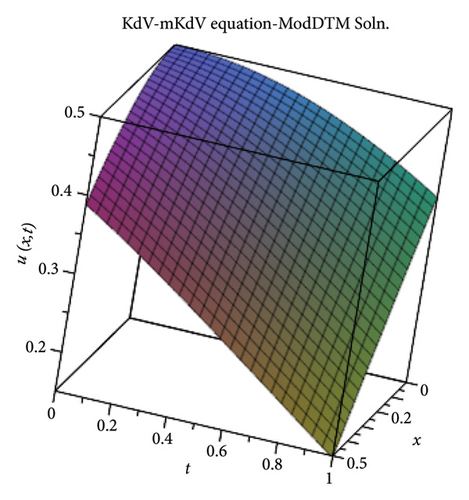
3.3. The H-S Equation
The absolute errors of the six-term ModDTM solution are given in Table 3, and the graphs of the exact and ModDTM solution are given in Figure 3.
| x | t = 0.0 | t = 0.25 | t = 0.5 | t = 0.75 | t = 1.0 |
|---|---|---|---|---|---|
| 0.0 | 0.00 | 0.00 | 0.00 | 0.00 | 0.00 |
| 0.1 | 1.289e − 8 | 2.601e − 8 | 5.842e − 8 | 1.517e − 7 | 4.856e − 7 |
| 0.2 | 7.708e − 7 | 1.542e − 6 | 3.426e − 6 | 8.766e − 6 | 2.749e − 5 |
| 0.3 | 8.241e − 6 | 1.637e − 5 | 3.602e − 5 | 9.107e − 5 | 2.809e − 4 |
| 0.4 | 4.364e − 5 | 8.612e − 5 | 1.880e − 4 | 4.704e − 4 | 1.432e − 3 |

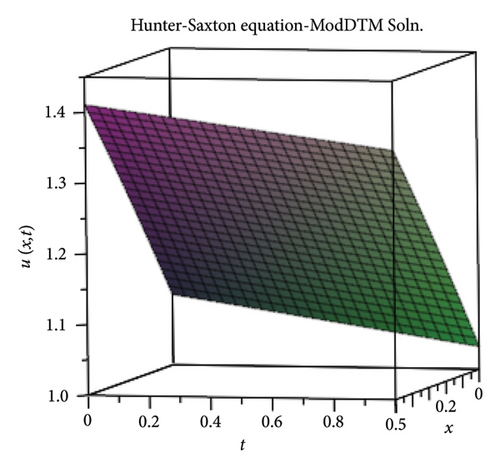
3.4. The FW Equation
3.5. The WBK Equations
Tables 4 and 5 provide the absolute errors of the seven-term truncated series (71) and the six-term (72). Figures 4 and 5 show the exact solutions and the ModDTM solutions for u(x, t) and v(x, t).
| x | t = 0.0 | t = 0.1 | t = 0.2 | t = 0.3 | t = 0.4 | t = 0.5 |
|---|---|---|---|---|---|---|
| 0.00 | 0.00 | 0.00 | 0.00 | 0.00 | 0.00 | 0.00 |
| 0.05 | 4.300e − 8 | 3.830e − 8 | 2.340e − 8 | 4.000e − 9 | 1.100e − 8 | 2.300e − 8 |
| 0.10 | 5.438e − 6 | 5.046e − 6 | 3.302e − 6 | 9.011e − 7 | 1.304e − 6 | 2.707e − 6 |
| 0.15 | 9.110e − 5 | 8.771e − 5 | 6.058e − 5 | 2.060e − 5 | 1.783e − 5 | 4.369e − 5 |
| 0.20 | 6.643e − 4 | 6.627e − 4 | 4.809e − 4 | 1.921e − 4 | 9.854e − 5 | 3.046e − 4 |
| x | t = 0.0 | t = 0.1 | t = 0.2 | t = 0.3 | t = 0.4 | t = 0.5 |
|---|---|---|---|---|---|---|
| 0.00 | 0.00 | 0.00 | 0.00 | 0.00 | 0.00 | 0.00 |
| 0.05 | 6.020e − 6 | 5.400e − 6 | 3.370e − 6 | 7.000e − 7 | 1.660e − 6 | 3.080e − 6 |
| 0.10 | 3.789e − 4 | 3.554e − 4 | 2.363e − 4 | 6.924e − 5 | 8.628e − 5 | 1.868e − 4 |
| 0.15 | 4.209e − 3 | 4.115e − 3 | 2.905e − 3 | 1.064e − 3 | 7.404e − 4 | 1.983e − 3 |
| 0.20 | 2.285e − 2 | 2.325e − 2 | 1.733e − 2 | 7.457e − 3 | 2.737e − 3 | 1.018e − 2 |
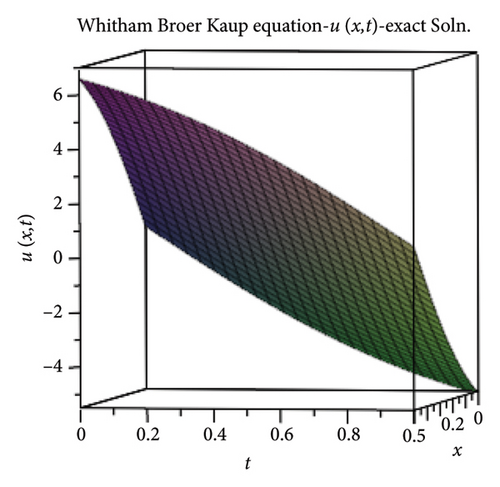
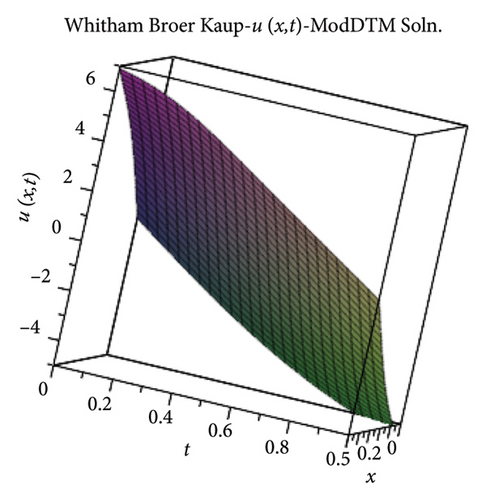
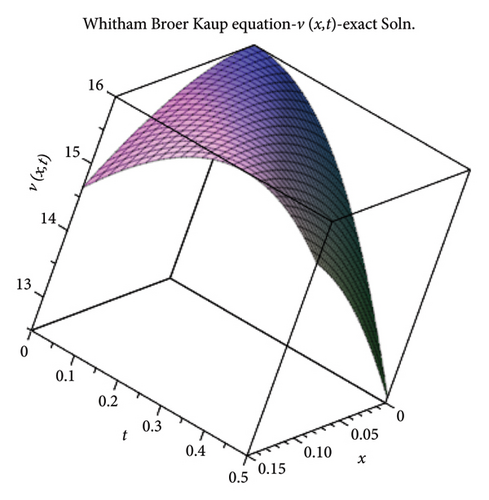
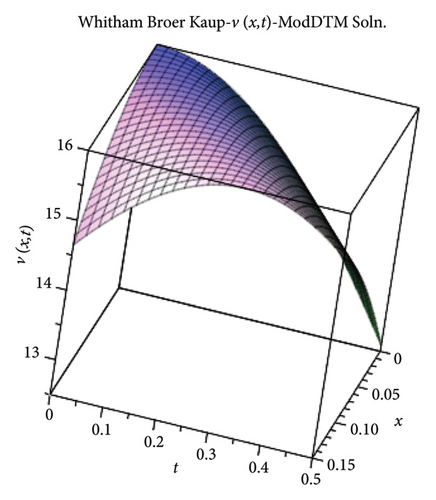
3.6. The Coupled s-G Equations
The coupled nonlinear s-G equations is a reduced form of the Klein–Gordon equations with a potential function given by f(u, w) = cos(u − w) − 1. Both systems represent one dimensional nonlinear wave processes in bi-layer media such as hydrogen-bonded chains and molecular crystals (Frenkel–Contorova dislocation model) [37]. Other applications of the s-G equations include the representation of fluxon phenomena of stacked intrinsic Josephson junction in high temperature superconductors, and the description of open states in DNA [37, 38].
3.7. Volterra Integral Equation 1
3.8. Volterra Integral Equation 2
The sum on the right-hand-side converges to the exact solution of the integral equation given by sinh(t − x) [40].
3.9. First Order PIDE
The series on the right-hand-side converges to u(x, t) = ex cos t, which is the exact and closed form solution of PIDE (109) [41].
3.10. Second Order PIDE
3.11. Volterra PIDE
3.12. Linear Schröedinger Equation
3.13. Nonlinear Schröedinger Equation
This is the same solution obtained in [19], and is the exact solution.
4. Comparison of the ModDTM With Other Methods
While the ModDTM generates solutions in the form of a power series of x with functions of t as coefficients, other methods, with the exception of DTM, generally provide solutions that are power series of t with functions of x as coefficients. In all of these cases, good approximations of the exact solutions will be obtained with very few terms, but, this will happen only in small neighborhoods of the variable in which the series is represented: in the vicinity of x = 0 for the ModDTM, and t = 0 in the other cases. Comparatively larger values of the remaining variable will not affect the convergence considerably. As an exception comes the case of the DTM for which convergence occurs in small neighborhoods of the point about which the series has been determined, which is usually the origin (0, 0), since the solutions are in the form of a Taylor series. Besides, a larger number of terms may be needed to get the same level of accuracy.
The tables that follow verify what have been stated above. In Table 6 the Exact, ModDTM, DTM and EHTPM solutions in the immediate neighborhood of (0, 0) are displayed. The good agreement of the values is evident on examination of the table.
| (x, t) | Exact | ModDTM | DTM | EHTPM |
|---|---|---|---|---|
| (0.0, 0.0) | 0.25 | 0.25 | 0.25 | 0.25 |
| (0.0, 0.1) | 0.3874,556,189 | 0.3874,556,189 | 0.3874,348,958 | 0.3874,556,206 |
| (0.0, 0.2) | 0.5344,466,455 | 0.5344,466,455 | 0.5333,333,333 | 0.5344,511,614 |
| (0.1, 0.0) | 0.2256,447,723 | 0.2256,447,916 | 0.2256,447,708 | 0.2256,447,723 |
| (0.1, 0.1) | 0.3584,269,144 | 0.3584,269,582 | 0.3584,213,332 | 0.3584,269,144 |
| (0.1, 0.2) | 0.5054,491,951 | 0.5054,492,160 | 0.5048,333,125 | 0.5054,506,464 |
| (0.2, 0.0) | 0.2026,494,300 | 0.2026,500,000 | 0.2026,493,333 | 0.2026,494,300 |
| (0.2, 0.1) | 0.3299,842,050 | 0.3299,856,093 | 0.3099,831,875 | 0.3299,842,035 |
| (0.2, 0.2) | 0.4760,647,847 | 0.4760,654,792 | 0.4757,493,320 | 0.4760,629,844 |
Table 7 exhibits the solution of the Fishers equation for values of t that are comparatively larger than that of x. It is seen that the ModDTM solution compares favorably with the exact solution, while the others deviate considerably. This property is reversed when it is x that is large, as seen in Table 8.
| (x, t) | Exact | ModDTM | DTM | EHTPM |
|---|---|---|---|---|
| (0.1, 1.0) | 0.9852,715,523 | 0.9852,715,530 | 0.404,504,145 | 170.94,775,160 |
| (0.1, 2.0) | 0.9998,996,575 | 0.9998,996,581 | 86.69,690,510 | 220,719.69240 |
| (0.1, 3.0) | 0.9999,993,240 | 0.9999,993,236 | 965.5,090,979 | 13,376,912.170 |
| (0.1, 4.0) | 0.9999,999,960 | 0.9999,999,956 | 4733.872,333 | 241,919,574.50 |
| (0.1, 5.0) | 1.0000000000 | 1.0000000000 | 15,660.69285 | 2,272,864,165.0 |
| (x, t) | Exact | ModDTM | DTM | EHTPM |
|---|---|---|---|---|
| (1.0, 0.1) | 0.14253,695,660 | 0.1465,278,638 | 0.1425,130,207 | 0.14253,695,660 |
| (2.0, 0.1) | 0.03327,907,174 | 0.1275,086,155 | 0.0173,828,125 | 0.03327,907,174 |
| (3.0, 0.1) | 0.00575,446,348 | 0.4852,141,971 | −0.269,205,729 | 0.00575,446,348 |
| (4.0, 0.1) | 0.00085,920,687 | 1.3435,966,890 | −1.623,502,605 | 0.00085,920,688 |
| (5.0, 0.1) | 0.00012,071,291 | 2.7957,439,310 | −5.826,757,813 | 0.00012,071,291 |
which is the transform of the equation in the DTM.
5. Results and Discussion
This study was intended to examine if the ModDTM, which is a method in which the search direction of the solution is along the x axis, would yield satisfactory results as any other traditional method that solves initial value problems of the time variable. The other aim was to establish the versatility of the method, by showing that it could be applied to a wide variety of equations including, differential, integral, and PIDE.
To examine the viability of the new approach, and the adaptability of the ModDTM to various types of equations, the method was applied to four nonlinear PDE such as the Fishers, the KdV-mKdV, the H-S, and the FW equations, two systems of NLPDEs, viz., the WBK and the sine − Gordon equations, two integral equations, three PIDE, and linear and nonlinear versions of the complex Schröedinger equation. Except for the Fishers, the KdV-mKdV, the H-S, and the WBK equations, it was possible to identify the closed form of the ModDTM solutions, which coincided with the exact solutions. Even though the same cannot be claimed for the remaining equations, the truncated solutions, with only a few numbers of terms, showed a very high rate of convergence with the exact ones. For example, for the five-term truncated series solution of the Fishers equation the absolute error deviated from 7.915 × 10−10 to 4.117 × 10−5. The 3D graphs also showed the good agreement existing between the exact and the ModDTM solutions. Convergence was also verified by observing that the αk were less than one. Similar analyses for the KdV-mKdV, H-S, and the WBK equations provide matching results. In the case of the WBK system, it was found that the window of convergence of the ModDTM solutions was comparatively smaller. This drawback may be improved by including more terms in the truncated series. The analysis is that the errors occurring for each function affect the other function as well, as they are interdependent. Again, v is seen to deviate more from the corresponding exact solution than u. The reason behind this rests in the fact that the series for the former had 6 terms, whereas for the latter it had 7. This happened because, to determine each Uk, Vk−1 had to be computed first symbolically.
It is also to be noted that no change of variable was needed to solve the H-S and FW equations which had cross derivatives.
6. Conclusion
This paper presents a modification of the Differential Transform Method (ModDTM) formulated so that the search direction of the solution is along a spatial axis (x). This means that solutions are sought for given initial values at x = 0, instead of at t = 0. To achieve this, a given equation is transformed to an ODE in t by using the ModDT and its properties, which are then applied recursively to find the solution. The recurrence relations used in the application of the ModDTM are less complex than their corresponding counterparts in the DTM, and as such the former method is simpler and easier to apply than the latter. Moreover, the fact that only a few number of terms is needed in the approximate truncated ModDTM-solution to produce good levels of convergence, shows that the volume of computations required for satisfactory results is low as well. The method has been well illustrated by solving a wide spectrum of equations including nonlinear PDE, integral equations, PIDE, and complex equations.
One of the aspects of the ModDTM that may be improved is that in its present form the method is applicable only to (1 + 1) PDEs. This situation may be changed by adapting the method for solving equations of higher dimensions. Suitable adaptations of the method may also make it good for fractional PDEs, especially space-fractional equations. Another possibility for future development is to adapt the ModDTM to suit boundary value problems of PDEs, since the method focuses on finding solutions in the x-direction, being prescribed initial data corresponding to the spatial variable.
Conflicts of Interest
The authors declare no conflicts of interest.
Funding
The authors declare that funding of any kind was not received for this research or for the publication of this paper.
Open Research
Data Availability Statement
No underlying data were collected or produced in this study.




